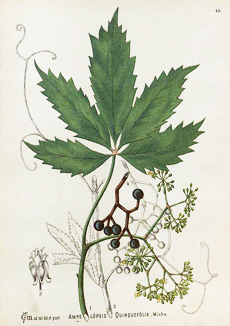Viney Virginia Creeper
By Audrey Stallsmith

. . .then she swayed, lost her balance, stumbled, staggered, and fell, sliding down over the sun-baked roof and crashing off it through the tangle of Virginia Creeper beneath—all before the dismayed circle below could give a simultaneous, terrified shriek.
Anne of Green Gables by L. M. Montgomery
A Virginia Creeper vine on the north wall of our garage has arched to make an almost perfect half-frame just over a large fern growing at the back of my garden there. I thought that was very clever of the plant, since I probably now will leave it in place.
Many of us are guilty of leaving this particular wilding in place—or even of planting it ourselves—simply because its “leaves of five” are so attractive, as are its purple berries and red or purple fall foliage. Native to the rest of eastern and central North America as well as to Virginia and sometimes called American ivy, it reportedly was exported to Europe as soon as the early 1600s. For obvious reasons, it stands for “I cling to thee” in the Language of Flowers.
It manages that clinging via little adhesive pads, as if it were producing its own Sticky Putty! Although it once was included in the ivy (Hedera) genus, it now is called Parthenocissus quinquefolia, which means respectively “virgin ivy” and “five-leaved.”
Virginia Creeper actually is more closely related to grapes than to ivy, its small clusters of yellow-green summer flowers being followed by pea-sized purple fruits in autumn. However, those berries are “strongly purgative.” That means the oxalic acid in them can cause diarrhea and, perhaps, vomiting. Fortunately, they aren’t toxic to birds.
Actually, the vine’s foliage must be at least somewhat poisonous as well, since a decoction made from it once was used to kill head lice. Some people even mistake it for poison ivy. Hence, the reminder rhyme: “Leaves of three, let them be; leaves of five, let them thrive.” Virginia Creeper reportedly can blister the skin of a small percentage of people too, though, which may be what caused the original error.
This creeper has been used in the past to treat a variety of ailments from constipation, headache, and spasms to the plague. These days, however, we had best avoid cures which are likely to make us sicker! But, due both to its prettiness and its poison, I think this vine well symbolizes the arrival of the bittersweet autumn season.
As Charles Dickens writes in The Mystery of Edwin Drood, “Not only is the day waning, but the year. The low sun is fiery and yet cold behind the monastery ruin, and the Virginia creeper on the cathedral wall has showered half its deep-red leaves down on the pavement.”
Parthenocissus quinquefolia image is by C. F. Millspaugh from American Medicinal Plants, courtesy of plantillustrations.org.








